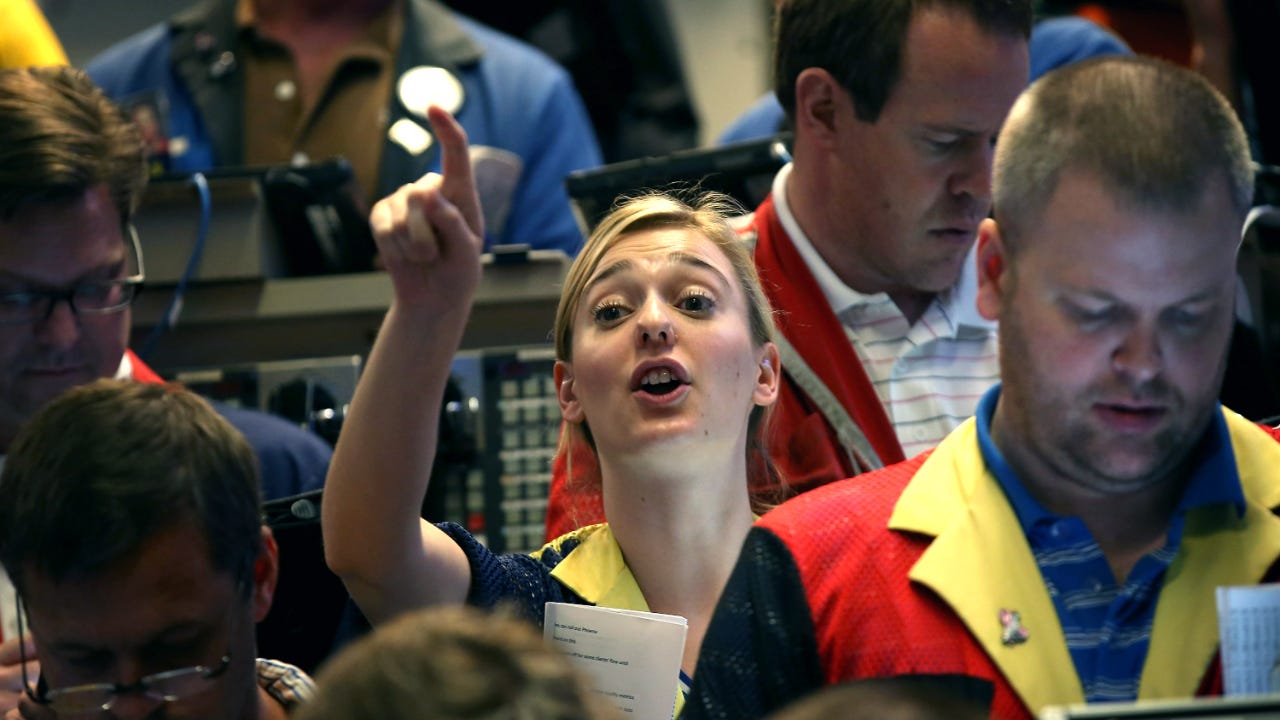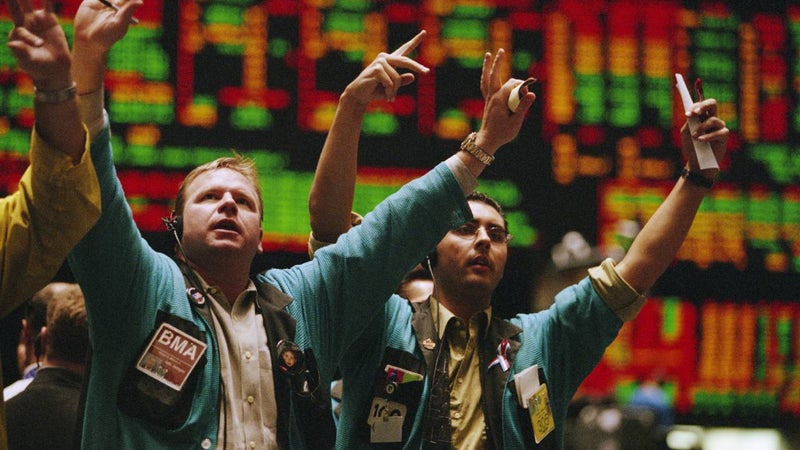What is options trading? A basic overview

The Bankrate promise
At Bankrate we strive to help you make smarter financial decisions. While we adhere to strict , this post may contain references to products from our partners. Here's an explanation for .
Options trading can be one of the most lucrative ways to trade in the financial markets. Traders only have to put up a relatively small amount of money to take advantage of the power of options to magnify their gains, allowing them to multiply their money many times, often in weeks or months.
Here’s how options work, the benefits and risks of options and how to start trading options.
What are options?
An option is the right, but not the obligation, to buy or sell a stock (or some other asset) at a specific price by a specific date. An option has a definite life, with a fixed expiration date, after which its value is settled among options traders, and the option ceases to exist. The option expires either with a definite value or worthless, making options a high-risk, high-reward trade.
Options trade on a public exchange, and their price is affected by the ups and downs of the underlying stock. Here are the major terms to know when trading options:
- Underlying stock: The stock represented by the option. Each stock has its own distinct set of options.
- Strike price: The price at which the option allows you to buy or sell the underlying stock. A stock might have dozens of different options with different strike prices.
- Premium: This is the price of the option, whether you’re the buyer or the seller.
- Expiration: This is the date that the option expires. After the expiration, the option is settled and will no longer exist.
- Options contract: Options are generally sold in what’s called a contract, which represents 100 shares of the underlying stock.
Options are quoted in the price per share of stock, rather than the price to own an actual contract. For instance, the last quoted price on an option may be $1.25. To buy that contract, it would cost 100 shares per contract * 1 contract * $1.25, or $125.
Types of options
There are two major types of options, and they both allow traders to make money regardless of whether a stock goes up or down:
- A call option allows the owner to buy the underlying stock at the strike price up until the option’s expiration. When the stock price rises, the call option increases in value, all else equal. If you’re buying a call option, you usually expect the stock price to rise. If you’re selling a call option, you’re probably expecting the stock to stay flat or decline.
- A put option allows the owner to sell the underlying stock at the strike price up until the option’s expiration. When the stock price falls, the put option increases in value, all else equal. If you’re buying a put option, you usually expect the stock price to fall. If you’re selling a put option, you’re probably expecting the stock to stay flat or rise.
These are the two major kinds of stock options, but options traders can create other types of options strategies using these two basic types. These complex options strategies can make money if the stock behaves in a certain way or can be used to generate income, for example. But even new options traders can use beginning options strategies to make extra money.
How options work
We’ve laid out the basics of how options work, now let’s run through a specific example to show how they work in practice.
Let’s imagine that stock XYZ is trading for $20 per share, and you can buy a call option on the stock with a $20 strike price for $1, with an expiration in six months. The option contract costs $100, or 100 shares per contract * 1 contract * $1 per share.
Here’s how much a trader would make at expiration, as a function of the stock price.
If the stock price finishes expiration above the strike price, the call option is in the money. Above the strike price, every $1 dollar increase in the stock price equals a $100 gain for the value of the option. For example, as the stock moves from $23 to $24, the option value moves from $300 to $400, or a gain of 33 percent. Subtract the $100 cost of the option to find the trade’s profit.
In this example, the option costs $100, so the option does not break even until the stock price is over $21 per share. However, as long as the stock closes above the strike price, it’s worth at least some money. So, with the stock between $20 and $21 per share at expiration, the option trader will still have some money left from the trade, but the trade will be a net loser.
If the stock finishes expiration at $20 or below, the option will expire worthless, and the trader will lose any money put into the trade.
So, the appeal for options traders is that they can make a lot more in percentage terms than they can by buying the stock. For example, If the stock rises from $20 to $25 at expiration, then the stock buyer would have earned a 25 percent profit. Meanwhile, the options trader in this example would have earned a return of 400 percent (a $400 gain divided by the $100 cost), not factoring in the cost of any commissions.
And that potential for magnifying your gains is what makes options trading so interesting.
How options are priced
Options prices have two parts: intrinsic value and time value. Here’s how they work:
- Intrinsic value: The intrinsic value is how much the option is “in the money.” For example, if you have an option with a strike price of $40 and the stock is at $45, the intrinsic value portion of the option premium is $5.
- Time value: Everything that’s not part of the option’s intrinsic value is classified as time value. This portion of the option’s value factors in how much time is left until expiration, the volatility of the underlying stock and prevailing interest rates, among other things. For example, if an option with a strike price of $40 is trading for $8 when the stock is at $45, the option has a time value of $3, because its intrinsic value is $5.
An option’s time value is an important factor to understand because it will continue to decay as the option approaches its expiration. Even options that have no intrinsic value can have time value as long as they have some time left until expiration. So if a stock price is below an option’s strike price, the value of the option will be completely time value. (Some options traders bet on “zero-day options” – options that expire at the end of the day because they have little time value and the potential for explosive gains.)
The price of an option depends on many factors, including the following:
- The stock price: The price of the option will adjust as the stock price rises or falls. For call options, the premium will rise as the stock rises, and vice versa. For put options, the premium will rise as the stock falls, and vice versa.
- The strike price: The difference between the strike price and the stock price is a key factor in determining the option’s value.
- The option’s time to expiration: The longer until expiration, the higher the option’s price, since an option seller wants to be compensated for a higher range of potential outcomes.
- The stock’s volatility: The higher the underlying stock’s volatility, the higher the option price since an option seller wants to be compensated for potential lost upside.
- Prevailing interest rates: The higher the interest rate, the higher the option price, since interest rates are the opportunity cost of money deployed elsewhere.
- The stock’s dividend: The higher the dividend, the more it exaggerates an option’s price, pushing down the price of calls and raising the price of puts.
- Short interest on the stock: For stocks with high short interest – where investors are short selling the stock – options prices are higher.
- Demand for the option: Investors may have a particular interest in a specific option, helping to push up its price.
Those are some of the major factors at play in the pricing of an option, but it’s important to know that one of the biggest is simply the time until the option’s expiration.
Benefits of trading options
Trading options offers a number of benefits for an active trader:
- Options can offer high returns and do so over a short period, allowing you to multiply your money quickly if your wager is right.
- With options, it can cost less to get the same exposure to a stock’s price movement than it does to buy the stock directly.
- Options prices can be volatile, giving traders an opportunity to profit on the fluctuation in price, even from a relatively small change in the price of the underlying stock.
- While many options strategies are risky, some options strategies such as the covered call are relatively safe and can increase your profit as an investor. There are also covered call funds that will execute the strategy for you.
- If a stock rises for almost any reason, such as a buyout, option owners can enjoy that potential upside.
- Options commissions are the lowest they’ve ever been, meaning it’s cheaper than ever to trade options at the best brokers for options traders.
- Options are generally liquid, meaning that you’ll usually be able to trade them for cash whenever the market is open, though you may lose money on them.
- If you hold options for a year or longer, you qualify for favorable long-term capital gains tax rates, though long-term options – called LEAPs – are not available on all stocks.
Risks of trading options
In return for the potential benefits of options, traders have to put up with a number of risks or disadvantages:
- With options you not only have to pick the right investment thesis – which stock is going to move – but you also have to time it correctly. A stock that moves after an option expires is meaningless to the option holder.
- If the price of the underlying stock moves unfavorably in the short term, the price of the option may never recover before expiration, leaving the option worthless.
- Options prices are tremendously volatile and can move substantially from day to day — even within the same day. Some traders see this as an advantage.
- Because options are not guaranteed by the government, you can lose (a lot of) money on them.
- For certain options strategies, traders can lose more money than they invest in them.
- Unlike stocks, which can exist as long as the underlying company is solvent, options have a definite life and then expire. At expiration, the opportunity to trade them is over, and so options are not suitable for buy-and-hold investors.
- Options generally cost more to trade than stocks, where the commission at most major online brokers is zero. A handful of brokers offer commission-free option trading, however.
Many traders choose stocks over options, because they can still generate attractive returns over the long term, without the risk of total loss on options.
How to start trading options
If you’re thinking about trading options, it’s actually surprisingly easy to start, and you don’t need a lot of money to get going.
1. Find an options broker
Your first step is to find an options broker that works for you. If price is your only objective, then you might find apps such as Webull or Robinhood interesting. If you want a more full-featured experience, then you have numerous other choices. You may want to trade other securities, so it can be worthwhile to look at the best all-around brokers.
2. Open an account and deposit money
After you’ve found a broker that suits your needs, you can open the account and deposit money. With your financial details in hand, you can open most accounts in less than 15 minutes and then proceed to funding the account. For some accounts, it may take several days for the money from your bank to clear and become available in the brokerage account.
3. Research your trade and pick your options
This stage is the single most important. Before you place your trade, you need to know what you want to trade, and that can require a lot of work. You’ll want to understand the company you’re thinking about trading options in, so that you can make a smart decision. What’s the competitive situation? Is the stock poised to rise in the near term or longer out? From there, you can create an option strategy that fits your expectations.
4. Place your trade
Once you’ve decided which options you’ll be trading, you can place your trade. It’s important to use a limit order (not a market order) when placing options trades, or you might wind up with a much different price for your trade than you expected.
While it won’t take a lot of money to get started trading options, new traders should remember that one bad trade could wipe out your whole bankroll. So it’s important to manage your risk carefully and never trade with more money that you’re able to lose comfortably. While you can make money quickly with options, you can lose it just as quickly.
Bottom line
Trading options can be tremendously lucrative for those who know what they’re doing, but it can also be tremendously risky for those who don’t or even those who simply get caught in a bad trade. That’s why it’s important to understand the risks you’re running for those potential rewards, and you’ll need to decide for yourself whether trading options is something you want to do.
Editorial Disclaimer: All investors are advised to conduct their own independent research into investment strategies before making an investment decision. In addition, investors are advised that past investment product performance is no guarantee of future price appreciation.


